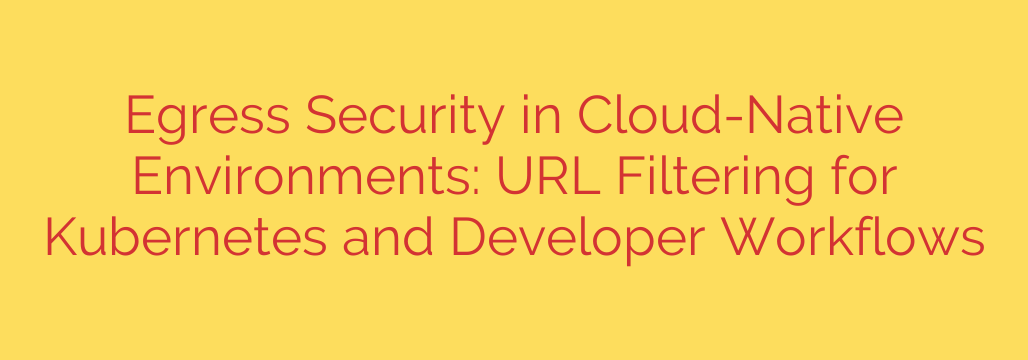
Mastering Kubernetes Egress Security: A Guide to URL Filtering
In the world of cybersecurity, we spend a lot of time fortifying the castle walls. We focus intensely on ingress security—controlling who and what gets into our networks. While this is critical, it overlooks a significant and often exploited vulnerability: the traffic leaving our environment. This outbound traffic, known as egress, is the forgotten back door that attackers use for data theft and maintaining control over compromised systems.
For organizations running on modern, cloud-native platforms like Kubernetes, managing egress traffic presents a unique and complex challenge. Traditional security models simply weren’t built for the dynamic, ephemeral nature of containers.
Why Traditional Security Falls Short in Cloud-Native Environments
In legacy, on-premise environments, security was often managed with IP-based firewalls. You could create a rule that says “this server at IP address 10.0.1.5 can talk to the server at 20.0.2.10.” This worked because infrastructure was static.
In Kubernetes, this model breaks down completely:
- Pods are Ephemeral: Pods are created and destroyed constantly, each time receiving a new, unpredictable IP address. Creating rules based on pod IPs is an unwinnable game of whack-a-mole.
- External Services Use Dynamic IPs: Your applications need to connect to external services like GitHub, AWS S3 buckets, or third-party APIs. The IP addresses for these services change frequently and without warning. An IP-based rule that works today might fail tomorrow.
Relying on outdated, IP-based security measures in a Kubernetes environment is like trying to guard a building where the doors and windows are constantly moving. It’s ineffective and creates a false sense of security.
The Kubernetes Egress Blind Spot: Key Challenges
Uncontrolled egress traffic is not just a theoretical problem; it’s an active threat vector that malicious actors exploit. Understanding the specific risks within Kubernetes is the first step toward building a stronger defense.
Data Exfiltration: If an attacker gains a foothold inside one of your containers, their primary goal is often to steal sensitive data. Without strict egress controls, they can easily send customer information, intellectual property, or access credentials to an external server they control.
Command-and-Control (C2) Communication: A compromised container can “call home” to a malicious command-and-control server. This allows an attacker to maintain persistent access, issue new commands, and pivot to other parts of your network.
Downloading Additional Malware: An initial breach is often just the beginning. Attackers use outbound connections to download more sophisticated tools, such as ransomware or crypto-mining software, directly into your environment.
Balancing Security and Developer Productivity: The most obvious solution might seem to be blocking all outbound traffic. However, this would bring development to a halt. Developers rely on external access to registries like Docker Hub, package managers like npm and PyPI, and source control systems like GitHub. The challenge is to allow legitimate traffic while blocking malicious activity.
The Modern Solution: URL Filtering for Granular Control
To effectively secure a dynamic environment like Kubernetes, you need a more intelligent and flexible approach. This is where URL filtering based on Fully Qualified Domain Names (FQDNs) becomes essential.
Instead of creating rules based on fragile IP addresses, FQDN-based policies allow you to define access based on stable, human-readable domain names. For example, you can create a policy that states: “Pods in the ‘billing-api’ namespace are only allowed to communicate with api.stripe.com and s3.us-east-1.amazonaws.com.”
This approach offers several powerful advantages:
- Stability and Reliability: Domain names rarely change, even when their underlying IP addresses do. This makes your security policies resilient and low-maintenance.
- Clarity and Readability: Policies based on FQDNs are self-documenting. It is immediately clear what
allow: api.github.commeans, whereasallow: 140.82.121.3is obscure and requires constant verification. - Granular Control: You can be highly specific. For instance, you can allow access to
your-company.okta.comfor authentication but block all other traffic, significantly reducing the attack surface.
Implementing a Robust Egress Security Strategy: Best Practices
Securing egress traffic requires a strategic, multi-layered approach. Here are actionable steps you can take to protect your Kubernetes environment.
Adopt a Default-Deny Stance
The principle of least privilege is paramount. Start by blocking all egress traffic from your cluster by default. This forces you to consciously and explicitly define what outbound communication is necessary for each application. While this may seem strict, it is the most effective way to prevent unauthorized connections.Audit and Profile Your Traffic
You cannot secure what you cannot see. Use network observability tools to monitor and understand the existing egress traffic from your applications. This will reveal which external endpoints your services are connecting to, helping you build an accurate initial set of FQDN-based allowlist policies.Leverage FQDN-Based Allowlists
Transition from IP-based rules to FQDN-based policies. Define granular rules for each workload or namespace, specifying the exact domains they need to function. This ensures that a container built to process payments can only talk to your payment provider’s API and nothing else.Integrate Security into Your CI/CD Pipeline
Embrace a “shift-left” security mindset. Treat your network policies as code (Policy-as-Code) and store them in your version control system. By integrating policy validation into your CI/CD pipeline, you can ensure that no application is deployed without a compliant and secure egress policy.
Moving Beyond the Perimeter
In the cloud-native era, the concept of a secure perimeter has dissolved. Security must be built directly into the fabric of your applications and infrastructure. While ingress protection remains vital, it’s only half the battle.
By focusing on egress security and implementing granular, FQDN-based controls, you can close a critical security gap. This proactive approach not only protects against data exfiltration and other advanced threats but also builds a more resilient, manageable, and fundamentally secure Kubernetes environment.
Source: https://collabnix.com/cloud-native-egress-security-how-msp-managed-url-filtering-protects-kubernetes-and-developer-workflows/








